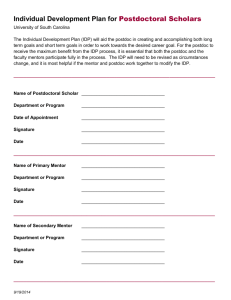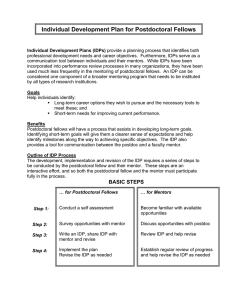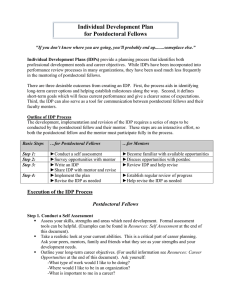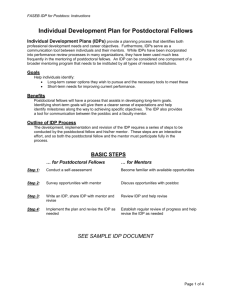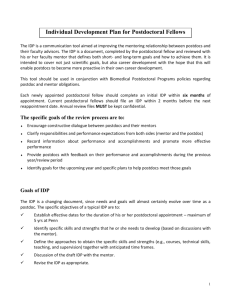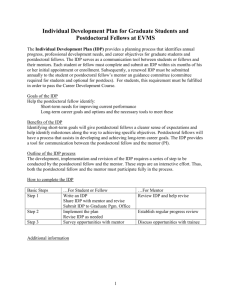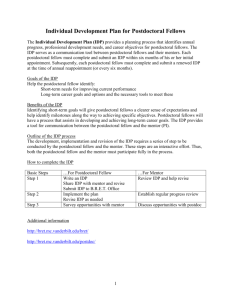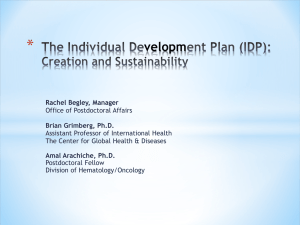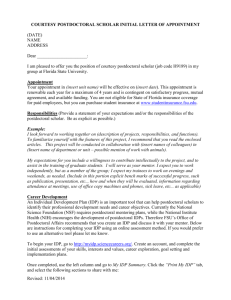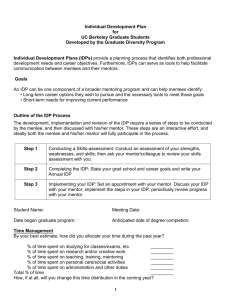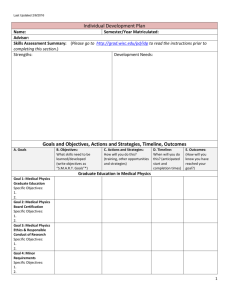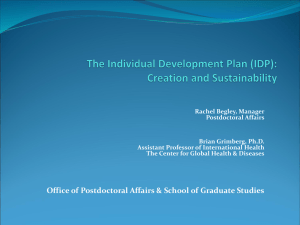Individual Development Plan - Office for Postdoctoral Scholars
advertisement
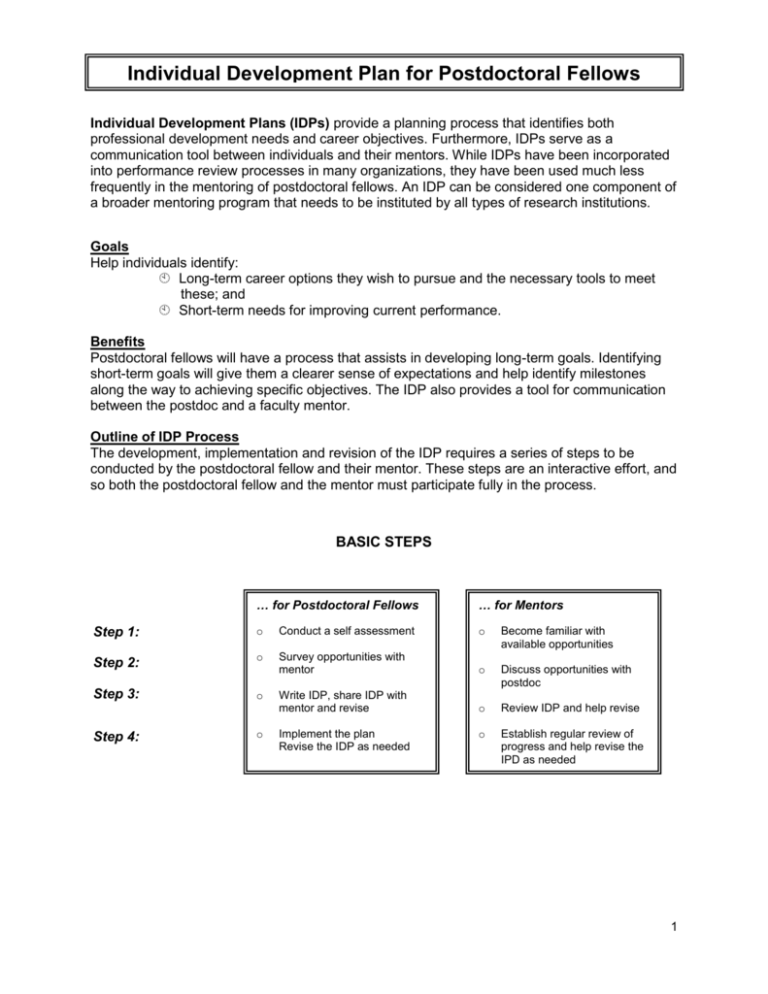
Individual Development Plan for Postdoctoral Fellows Individual Development Plans (IDPs) provide a planning process that identifies both professional development needs and career objectives. Furthermore, IDPs serve as a communication tool between individuals and their mentors. While IDPs have been incorporated into performance review processes in many organizations, they have been used much less frequently in the mentoring of postdoctoral fellows. An IDP can be considered one component of a broader mentoring program that needs to be instituted by all types of research institutions. Goals Help individuals identify: Long-term career options they wish to pursue and the necessary tools to meet these; and Short-term needs for improving current performance. Benefits Postdoctoral fellows will have a process that assists in developing long-term goals. Identifying short-term goals will give them a clearer sense of expectations and help identify milestones along the way to achieving specific objectives. The IDP also provides a tool for communication between the postdoc and a faculty mentor. Outline of IDP Process The development, implementation and revision of the IDP requires a series of steps to be conducted by the postdoctoral fellow and their mentor. These steps are an interactive effort, and so both the postdoctoral fellow and the mentor must participate fully in the process. BASIC STEPS Step 1: Step 2: Step 3: Step 4: … for Postdoctoral Fellows … for Mentors o Conduct a self assessment o Become familiar with available opportunities o Survey opportunities with mentor o Discuss opportunities with postdoc Write IDP, share IDP with mentor and revise o Review IDP and help revise o Establish regular review of progress and help revise the IPD as needed o o Implement the plan Revise the IDP as needed 1 Execution of the IDP Process … for Postdoctoral Fellows Step 1. Conduct a Self Assessment. Assess your skills, strengths and areas which need development. Formal assessment tools can be helpful. (Examples can be found in Resources: Self Assessment at the end of this document). Take a realistic look at your current abilities. This is a critical part of career planning. Ask your peers, mentors, family and friends what they see as your strengths and your development needs. Outline your long-term career objectives. (For useful information see Resources: Career Opportunities at the end of this document). Ask yourself: What type of work would I like to be doing? Where would I like to be in an organization? What is important to me in a career? Step 2. Survey Opportunities with Mentor. Identify career opportunities and select from those that interest you. Identify developmental needs by comparing current skills and strengths with those needed for your career choice. Prioritize your developmental areas and discuss with your mentor how these should be addressed. Step 3. Write an IDP. The IDP maps out the general path you want to take and helps match skills and strengths to your career choices. It is a changing document, since needs and goals will almost certainly evolve over time as a postdoctoral fellow. The aim is to build upon current strengths and skills by identifying areas for development and providing a way to address these. The specific objectives of a typical IDP are to: Establish effective dates for the duration of your postdoctoral appointment. Identify specific skills and strengths that you need to develop (based on discussions with your mentor). Define the approaches to obtain the specific skills and strengths (e.g., courses, technical skills, teaching, supervision) together with anticipated time frames. Discuss your draft IDP with your mentor. Revise the IDP as appropriate. Step 4. Implement Your Plan. The plan is just the beginning of the career development process and serves as the road map. Now it’s time to take action! Put your plan into action. Revise and modify the plan as necessary. The plan is not cast in concrete; it will need to be modified as circumstances and goals change. The challenge of implementation is to remain flexible and open to change. Review the plan with your mentor regularly. Revise the plan on the basis of these discussions. 2 …for Mentors Step 1. Become familiar with available opportunities. By virtue of your experience you should already have knowledge of some career opportunities, but you may want to familiarize yourself with other career opportunities and trends in job opportunities (refer to sources such as National Research Council reports and Science career reviews; see also Resources: Career Opportunities at the end of this document). Step 2. Discuss opportunities with postdoc. This needs to be a private, scheduled meeting distinct from regular research-specific meetings. There should be adequate time set aside for an open and honest discussion. Step 3. Review IDP and help revise. Provide honest feedback - both positive and negative - to help postdoctoral fellows set realistic goals. Agree on a development plan that will allow postdoctoral fellows to be productive in the laboratory and adequately prepare them for their chosen career. Step 4. Establish regular review of progress. The mentor should meet at regular intervals with the postdoctoral fellow to assess progress, expectations and changing goals. On at least an annual basis, the mentor should conduct a performance review designed to analyze what has been accomplished and what needs to be done. A written review is most helpful in objectively documenting accomplishments. (An example is provided as an attachment – this can be modified to fit the needs of the postdoc and mentor). This document was developed by the Federation of American Societies for Experimental Biology (FASEB)’s Science Policy Committee. For more information, contact: Jennifer A. Hobin, Ph.D., FASEB Office of Public Affairs (301-634-7650 or jhobin@faseb.org) 3 Postdoc Research and Career Progress: Annual Review Name: __________________________________Review Date: ___________ Department: ____________________________________________________ Advisor: _______________________________________________________ (Advisor’s Signature) Part 1. Progress Review: Research and Professional Training in the Past Year Brief overview of your research project and major accomplishments in the past year (one half page should be sufficient): Publications: Patents: Honors/Awards (include fellowships with entire funding periods, grants written/applied for/received, professional society presentation awards or travel awards, etc.): National or other professional meetings attended (indicate meeting title, oral or poster presentation): Seminar Presentations (title, department): New areas of research or technical expertise acquired in past year: Teaching activity: o Oversight of graduate, undergraduate or summer student (name, academic level, project title): o Course lectures (department, course name) or lab sections(section title, supervised/unsupervised): 4 Clinical activity: Committee or other service activity (indicate if you held an office): Other professional activities not identified above: Other activities (community, etc) with professional relevance: Part 2. Plans for the Up-coming year: Research and other training plans: Research project goals (brief paragraph): Anticipated publications (indicate projected titles): Anticipated meeting or workshop attendance: Fellowship or other funding applications planned (indicate name of award): Other professional training (course work, teaching activity): Career Goals: Current career goal(s): 1) 2) What further research activity or other training is needed before it is appropriate to start a job search? When do you anticipate beginning a job search? Please indicate if there are other issues that affect your job search (an international trainee with an assured position in home country): 5 6 Resources* Self Assessment Fiske, P. S. (2001). Put Your Science to Work: The Take-Charge Career Guide for Scientists. Washington, D.C.: American Geophysical Union. Bolles, R. N. (2002). What Color is your Parachute? A Practical Manual for Job-Hunters and Career-Changers. Berkeley, Calif.: Ten Speed Press. The Postdoc Experience Kern, S. (2002). Fellowship Goals for PhDs and MDs: A Primer on the Molecular Biology Postdoctoral Experience. Cancer Biology and Therapy 1: 74-75. National Academy of Sciences. (2000). Enhancing the Postdoctoral Experience for Scientists and Engineers: A Guide for Postdoctoral scholars, Advisers, Institutions, Funding Organizations, and Disciplinary Societies. Washington, D.C.: National Academy Press. Career Opportunities American Association for the Advancement of Science. Science’s Next Wave. [On-line]. Available: http://sciencecareers.sciencemag.org/ The Scientist. Archives: Profession. [On-line]. Available: http://www.thescientist.com/fragments/careers/careers_about.jsp The Chronicle of Higher Education. Career Network Advice Columns. [On-line]. Available: http://chronicle.com/jobs/ Federation of American Societies for Experimental Biology. (1997). Graduate Education: Consensus Conference Report. Bethesda, M.D. FASEB. [On-line]. Available: http://opa.faseb.org/pages/Publications/educationreport.htm Heiberger and Vick, eds. (1996). The Academic Job Search Handbook (2nd ed.). University of Pennsylvania Press. Reis, R. M. (1997) Tomorrow’s Professor. Preparing for Academic Careers in Science and Engineering. New York: IEEE Press. 1997. On-line Listserv: Tomorrow’s Professor. Available: http://ctl.stanford.edu/Tomprof/index.shtml Barker, K. (2002). At the Helm: A Laboratory Navigator. Cold Spring Harbor, NY: Cold Spring Harbor Laboratory Press. Resources on Non-Academic Careers Robbins-Roth, C. ed. (1998). Alternative Careers in Science. Leaving the Ivory Tower. San Diego, Calif.: Academic Press. Kreeger, K. Y. (1999). Guide to Nontraditional Careers in Science. London: Taylor & Francis Group. *these resources are not considered endorsements, per se 7
